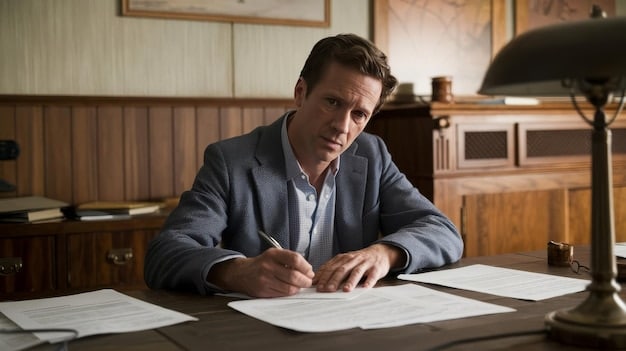Estate Planning Basics: Secure Your Family’s Future with a Will

Estate planning basics, especially creating a personal will, are crucial for protecting your family’s future by ensuring your assets are distributed according to your wishes and minimizing potential legal and financial burdens.
Protecting your family’s future starts with understanding the estate planning basics, particularly creating and maintaining a personal will. A will ensures your assets are distributed according to your wishes, providing peace of mind for you and security for your loved ones.
Understanding the Importance of Estate Planning
Estate planning might seem daunting, but it’s a crucial step in ensuring your family’s financial security. It involves making arrangements for managing your assets and healthcare decisions in the event of your incapacitation or death. This process protects your loved ones and ensures your wishes are honored.
A comprehensive estate plan includes several components, with a personal will often serving as its cornerstone. Understanding the significance of each element can provide you with a clearer vision of how to safeguard your family’s future.
Why Estate Planning Matters
Estate planning goes beyond simply distributing assets. It’s about ensuring your family is taken care of and your wishes are respected. Here’s why it’s important:
- Protecting Your Assets: Estate planning helps protect your assets from unnecessary taxes and legal challenges.
- Providing for Your Family: It ensures your loved ones are financially secure and cared for.
- Avoiding Probate: Proper planning can help your estate avoid a lengthy and costly probate process.
- Healthcare Decisions: Estate planning allows you to appoint someone to make healthcare decisions on your behalf if you become incapacitated.
Ignoring estate planning can lead to unintended consequences, such as assets being distributed according to state law rather than your personal wishes. Taking the time to create a solid plan can save your family significant stress and financial burden in the future.
In summary, estate planning is not just for the wealthy; it’s for anyone who wants to ensure their family is protected and their wishes are honored. It provides a framework for managing your affairs and offers peace of mind knowing your loved ones are taken care of.
Creating Your Personal Will: A Step-by-Step Guide
Creating a personal will is often the first step in estate planning. It’s a legal document that outlines how you wish your assets to be distributed after your death. This document helps avoid confusion and ensures your assets go to the right people.
Writing a will might seem complicated, but it doesn’t have to be. Here’s a simple step-by-step guide to help you get started:
Steps to Writing a Will
Follow these steps to create a comprehensive and legally sound will:
- List Your Assets: Begin by making a list of all your assets, including real estate, bank accounts, investments, and personal property.
- Choose Your Beneficiaries: Decide who you want to inherit your assets. These are your beneficiaries.
- Appoint an Executor: Select someone you trust to manage your estate and carry out the instructions in your will.
- Consider Guardianship: If you have minor children, designate a guardian to care for them.
- Draft the Will: Write the will, ensuring it clearly and accurately reflects your wishes. You can use online templates or consult with an attorney.

Ensure your will is signed and witnessed according to your state’s laws. Without proper signatures and witnesses, the will may not be legally valid. An attorney can provide valuable assistance in ensuring your will meets all legal requirements. Regularly review and update your will as your circumstances change to keep it relevant and effective.
In conclusion, drafting a personal will is a crucial step in estate planning. By following these steps, you can create a document that protects your family and ensures your wishes are honored.
Understanding Key Components of a Will
A will is more than just a list of assets and beneficiaries. It contains several key components that work together to ensure your wishes are carried out effectively. Understanding these components is crucial for creating a comprehensive and legally sound document.
Familiarizing yourself with these core elements will help you make informed decisions and ensure your will accurately reflects your intentions.
Core Elements of a Will
Here are the key components you need to know:
- Testator: The person making the will.
- Beneficiary: The person or entity who will inherit the assets.
- Executor: The person responsible for managing the estate and carrying out the instructions in the will.
- Guardian: The person designated to care for minor children.
The testator must be of sound mind and acting under their own free will when creating the document. Beneficiaries can include family members, friends, or charitable organizations. The executor should be someone trustworthy and capable of managing financial and legal matters. If you have minor children, selecting a reliable guardian is essential to ensure their well-being.
In summary, understanding the key components of a will is critical for creating a legally sound and effective document. By carefully considering each element, you can ensure your wishes are accurately reflected and your family is protected.
Navigating Probate and Estate Administration
Probate is the legal process of validating a will and administering an estate. Understanding this process can help you prepare your family for what to expect after your death. Proper planning can minimize the challenges and costs associated with probate.
Estate administration involves managing and distributing the assets of the deceased. This process is typically overseen by the executor named in the will.
Understanding the Probate Process
The probate process generally involves these steps:
- Filing the Will: The will is filed with the probate court.
- Notifying Heirs: The court notifies all heirs and beneficiaries.
- Inventorying Assets: The executor identifies and inventories all assets.
- Paying Debts and Taxes: The estate pays outstanding debts and taxes.
The process can be lengthy and complex, depending on the size and complexity of the estate. Proper estate planning can help streamline this process and minimize potential delays. Some strategies, such as creating a living trust, can help your estate avoid probate altogether. A living trust allows assets to be transferred outside of probate, providing greater privacy and efficiency.

In conclusion, understanding the probate process is an essential part of estate planning. By preparing for it and taking steps to minimize its impact, you can help your family navigate this challenging time with greater ease.
Updating Your Estate Plan: When and Why
An estate plan is not a one-time task. It needs to be reviewed and updated periodically to reflect changes in your life, family, and financial situation. Regular updates ensure your plan remains effective and continues to meet your needs.
Changes in your life circumstances can significantly impact your estate plan. It’s essential to revisit your plan whenever significant life events occur.
Reasons to Update Your Estate Plan
Here are some common reasons to update your estate plan:
- Marriage or Divorce: Marriage or divorce can significantly alter your beneficiary designations and asset distribution preferences.
- Birth or Adoption of a Child: Adding new family members requires adjustments to ensure they are adequately provided for.
- Significant Changes in Assets: Major changes in your financial situation, such as buying or selling property, require an updated assessment.
- Changes in Tax Laws: Changes in tax laws can affect your estate’s tax liability, necessitating adjustments to minimize taxes.
It’s wise to review your estate plan at least every three to five years, even if no significant changes have occurred. This periodic review ensures your plan still aligns with your goals and complies with current laws.
In summary, regularly updating your estate plan is crucial for ensuring it remains effective and relevant. By staying proactive and addressing changes promptly, you can protect your family and ensure your wishes are honored.
Common Mistakes to Avoid in Estate Planning
Estate planning can be complex, and it’s easy to make mistakes that can have significant consequences. Avoiding these common pitfalls can help ensure your plan effectively protects your family and assets. Careful planning and attention to detail are essential for creating a solid estate plan.
Being aware of potential errors can help you navigate the estate planning process with greater confidence.
Common Estate Planning Mistakes
Here are some mistakes to avoid when creating your estate plan:
- Failing to Create a Will: Dying without a will (intestate) means your assets will be distributed according to state law, which may not align with your wishes.
- Not Updating Your Plan: Failing to update your plan after major life events can lead to unintended consequences.
- Choosing the Wrong Executor: Selecting an unqualified or untrustworthy executor can result in mismanagement of your estate.
- Not Communicating Your Plan: Failing to discuss your plan with your family can create confusion and conflict.
It’s also crucial to properly fund any trusts you create. Failing to transfer assets into a trust renders it ineffective. Additionally, ensure your beneficiary designations on financial accounts align with your estate plan. Conflicting designations can lead to unintended asset distribution.
In essence, avoiding common estate planning mistakes requires careful attention to detail and proactive planning. By addressing these potential pitfalls, you can ensure your plan effectively protects your family and honors your wishes.
| Key Point | Brief Description |
|---|---|
| 📝 Create a Will | Outline your wishes for asset distribution after death. |
| 👪 Choose Beneficiaries | Decide who will inherit your assets. |
| 🔄 Update Regularly | Review and update your estate plan as life changes occur. |
| 🧑⚖️ Appoint Executor | Select a trustworthy individual to manage your estate. |
Frequently Asked Questions (FAQ)
▼
Estate planning involves making arrangements for managing your assets and healthcare decisions in case of incapacitation or death. It’s crucial for protecting your family’s future and ensuring your wishes are respected.
▼
A will typically includes the testator, beneficiaries, executor, and guardian (if applicable). Each component plays a vital role in ensuring your wishes are correctly carried out.
▼
You should review and update your estate plan every three to five years or whenever significant life events occur, such as marriage, divorce, birth of a child, or major changes in assets.
▼
Probate is the legal process of validating a will and administering an estate. You can avoid it by creating a living trust or using other estate planning tools that allow assets to transfer outside of probate.
▼
Common mistakes include failing to create a will, not updating your plan, choosing the wrong executor, not communicating your plan, and failing to properly fund trusts. Avoiding these mistakes ensures your plan’s effectiveness.
Conclusion
Understanding the estate planning basics and creating a personal will are vital steps in protecting your family’s future. By carefully planning and regularly updating your estate plan, you can ensure your assets are distributed according to your wishes, providing peace of mind for you and security for your loved ones.





